Whether it be wildfires or hurricanes, when extreme weather strikes and pushes people from their homes, they need somewhere to go. That’s why on Monday, the federal government announced three “comfort” centres in Nova Scotia will soon be upgraded to create more room for beds, medical equipment and power generators.
The upgrades are expected to cost just under $400,000 and will be paid for out of Ottawa’s Hurricane Fiona Recovery Fund — a $300-million pot of money set up in October 2022. The Atlantic Canada Opportunities Agency (ACOA) administers the bulk of the funding.
In total, the Fiona fund set aside $9 million for climate comfort centres. Other financial support from the fund includes $40 million to the shellfish sector, $11.6 million to help Prince Edward Island National Park repairs and $100 million to repair small harbours and replace lost fishing gear. The last day to apply for funding is March 31, 2024.
“It is vital that these facilities have the capacity, resources and tools to support and shelter our citizens when they need it most,” said Rural Economic Development Minister Gudie Hutchings, who is responsible for ACOA, in a statement. “And we also know that after the crisis, these centres help communities and businesses return to economic health and activity.
“Through the Hurricane Fiona Recovery Fund, the Government of Canada is able to help communities strengthen their climate comfort centres in Fiona-affected areas, building resilience and improving planning for future climate-related disasters.“
But the funding also reveals just how insufficient disaster preparedness and adaptation funding is, says Sierra Club Canada’s national programs director Gretchen Fitzgerald.
“Although the ACOA grant is welcome, more consistently allocated and increased funding is needed,” she told Canada’s National Observer. “One source of revenue would be Canada finally keeping its promise to stop fossil fuel subsidies tomorrow and increasing taxes on industries raking in record profits right now, such as oil and gas.
“Another source some communities might want to look at (and are looking at) is holding the oil and gas industry accountable through legal action and seeking costs for damages, which could then be allocated for preparing for climate change impacts,” she added.
Hurricane Fiona was one of the worst natural disasters to ever hit Canada and was among the 10 most expensive disasters around the world in 2022. It caused nearly $4 billion worth of damage, according to a study published by U.K. charity Christian Aid. The storm, which barrelled across the Caribbean and Eastern Canada, displaced 13,000 and killed at least 29 people.
Fitzgerald said it’s not the comfort centres being funded that’s the problem, it’s the “scope and reliable source of funding needed” that’s the issue.
Preparing for the impacts of climate change is crucial. The Canadian Climate Institute found the average cost of weather-related disasters has exploded in recent decades, having averaged $8.3 million per disaster in the 1970s to $112 million in the 2010s, representing a 1,250 per cent increase. The frequency of natural disasters is also expected to get worse as warming global temperatures make wildfires, hurricanes, droughts and other catastrophes more likely to occur.
Since 2015, Canada has invested $6.5 billion in climate change adaptation, including $2 billion announced in late 2022.
Canada published a national adaptation strategy over the summer that includes $1.6 billion over five years to reduce the risk of climate-related disasters, protect nature, improve health-care outcomes, and build resilient infrastructure. According to the federal government, for every dollar invested in climate change adaptation projects, $15 can be saved.
" just under $400,000 ...
" just under $400,000 ... will be paid for out of Ottawa’s Hurricane Fiona Recovery Fund — a $300-million pot of money set up in October 2022."
So $3 mil set aside in Oct 2022 wasn't spent, and now all of it is stretching to the amount required?
More questions than answers ...






Comments